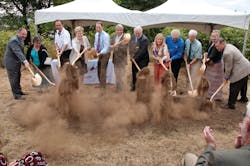Officials Break Ground for Keizer Transit Center
Salem-Keizer Transit, elected officials and community members celebrated the groundbreaking of the Keizer Transit Center.
The Salem-Keizer Transit Board of Directors welcomed U. S. Senator Ron Wyden, U.S. Representative Kurt Schrader, Oregon Senate President Peter Courtney, State Representative Kim Thatcher, Keizer Mayor Lore Christopher, Salem Mayor Anna Peterson and many community leaders. Said Board President Jerry Thompson, "Events like this celebrate, not only the start of construction, but the hours, days, months and, in some cases, years of hard work that go into putting together such a wonderful community facility."
Representative Schrader gave the keynote speech for the event, demonstrating his enthusiasm for transit and environmental sustainability. Schrader was key in securing the Federal Transit Administration $2.8 million "Livability Grant" helping to make this project a reality.
Keizer Station is currently served by Cherriots routes 4, 15, 18 and 19. The approximately 2,600 square foot building will have restrooms for employees as well as the public, and a small office. The Keizer Transit Center will include bus bays, passenger waiting areas, transit information, operator-break facilities, about 55 park-and-ride spaces, carpool drop-off and pick-up areas, and bicycle storage.
The center will also include sustainable design elements such as a green roof, solar panels, a ground source heat pump, electric vehicle charging stations and a water garden to manage stormwater runoff.
The approximately $3.6 million construction budget is being funded by federal and state grants for capital projects and building. "There is no local funding being used for this project," said Salem-Keizer Transit General Manager Allan Pollock. "We are reserving that for service." It is estimated that 100 or more skilled construction workers will be employed during the various phases of the project. An equivalent of 35 full time jobs will be created by the Keizer Transit Center.
The center is expected to be completed early next year. When operational, it will improve the livability, walkability and sustainability of the surrounding community and spur economic activity for surrounding businesses.
